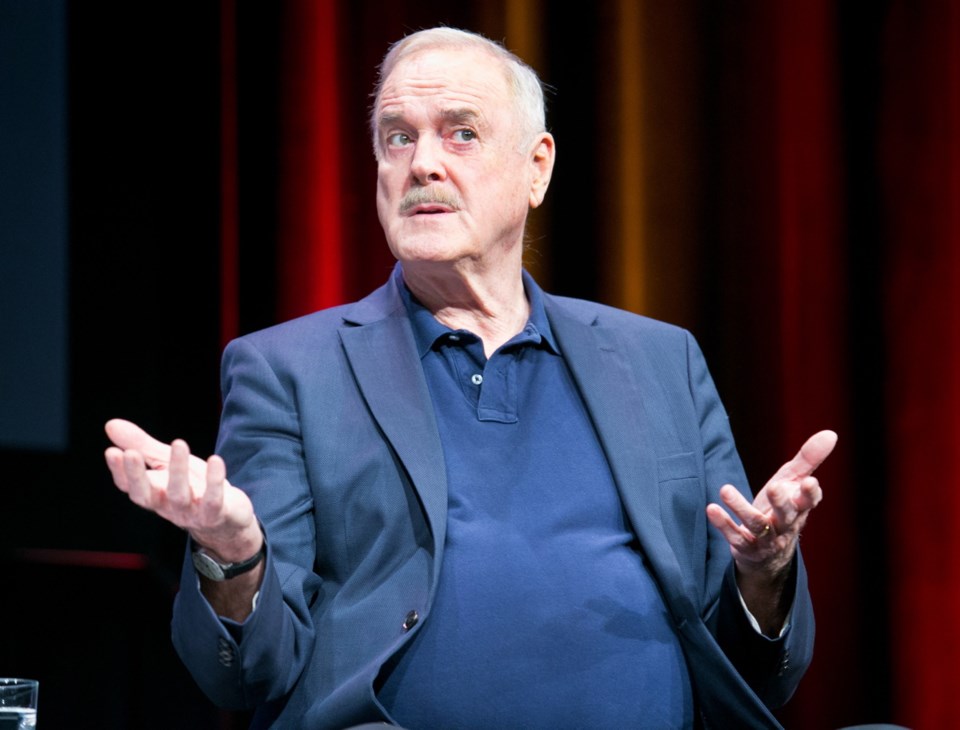What: John Cleese: Last Time to See Me Before I Die
Where: McPherson Playhouse
When: Continues to Oct. 23
Rating: 4 1/2 stars (out of five)
Monty Python, in essence, was all about being "silly," explained John Cleese.
This is best exemplified by the fish-slapping dance. The skit — mere seconds in length — shows two uniformed, pith-helmeted men. Once prances up to the other and slaps the other on the face with two small fish. The other (Cleese) unceremoniously pulls out an enormous fish and knocks the first man in a canal.
The routine, which Cleese screened Friday night, is indeed very silly. And very funny.
Victorians filled the McPherson Playhouse for the British comedian/writer's one-man show, Last Time to See Me Before I Die. Arguably the best known (and certainly the most recognizable) of the Monty Python troupe, the six-foot-five comedy legend was in strong form. Dressed comfortably in black blazer, navy tennis shirt and black loafers with no socks, Cleese — still sporting his little mustache — offered a brisk two-hour show of talk and film footage that delved into his comedy beginnings and spanned such career highlights as Monty Python's Flying Circus, Fawlty Towers, Monty Python and the Holy Grail and A Fish Called Wanda.
When someone is as famous as John Cleese, part of the appeal is just seeing the person in the flesh. Yet this 73-year-old isn't merely content to rest on his laurels which, in the comedy world, are haystack high. This show is carefully written, chockfull of fascinating biographical tidbits, hits all the high points and sufficiently irreverent (the f-word is tossed out several times) to remind us this old Python is as feisty and sharp as ever.
The most interesting part of the show is the first half, when Cleese examines his beginnings. He was born in 1939 in Weston-super-Mare, which was to serve as a model for the seaside resort town portrayed in Fawlty Towers. Cleese's mother, who shared her son's penchant for black humour, was neurotic and eccentric. Her list of fears (which she enjoyed discussing with her young son) included combine harvesters, Henry Moore sculptures and Princess Margaret. The most interesting thing about Cleese's father was that, upon enlisting in the army, he changed his named from "Cheese" to "Cleese" to avoid teasing.
To avoid bullying as a child who'd sprouted to six-feet by age 12, Cleese found acceptance by making people laugh. This was noted in back-handed fashion by an early, lisping teacher who wrote on his report card: "Cleese indulges in subversive activities at the back of the room."
A bright scholarship student, he soon signed up for the Footlights dramatic club at Cambridge University, a launching pad for many an English comedian. Cleese's gift for acting and especially writing was admired by fellow Footlights star David Frost, who — recognizing his talent — enlisted him for a revue that ended up playing London's West End and, even more remarkably, Broadway. Cleese immediately found work as a BBC comedy writer and rubbed shoulders with other gifted young men who would later form Monty Python.
Reflecting the zeitgeist of the 1960s, emerging comedian/writers favoured an absurdist style of humour that, in part, was a reaction to the oppressive mores of post-war Britain. Cleese recalled that in the early 1960s comedians steered clear of joking about the Prime Minister, as this was considered to be in poor taste. As a university student he was overjoyed to see a performance by Peter Cook and Dudley Moore in Beyond the Fringe, in which the pair poked boldly fun at Harold McMillan. Cleese laughed so hard "I think I bit my college scarf".
He ascribes many of his key comedy breaks to luck, but it's obvious Cleese and his co-horts (who included Marty Feldman early on) were brilliant young men destined for greatness. He described pitching what was to become Monty Python's Flying Circus to the head of BBC television's entertainment division. The newly-formed troupe soon realized, in trying to describe their show, they had thought nothing out beforehand.
"We had no idea of what we were going to do," Cleese said. Miraculously, they were promptly offered a 13-episode series, which aired in 1969.
Cleese showed a lot of video clips. In another context this might seem like a ploy for a performer to have a little rest between talking. But these well-chosen segments are, in fact, essential to the show. Among the most fascinating is footage from the funeral of fellow Python Graham Chapman, who died in his forties from cancer. In his eulogy Cleese said: "Good riddance, you free-loading bastard." It sounds terrible, but in fact, as Cleese explained, it was the sort of black humour (sabotaging formal public events) that Chapman adored.
There are sufficient behind-the-scenes nuggets to keep even the most fanatical Cleese fan happy. He told about how the real hotel-keeper upon which Basil Fawlty was modeled — a pompous, twitty man — took umbrage at his portrayal. Interestingly, Cleese also revealed some of his most celebrated bits were controversial and even considered for the cutting-room floor. These include the hysterical Black Knight sequence in Monty Python and the Holy Grail, in which the brave but dim-witted warrior keeps fighting after his limbs are hacked off one-by-one ("'Tis but a flesh wound").
At the outset, Cleese joked that he's touring Canada to generate funds to cover his massive alimony payments. This may be true, or it may not be. For fans, this was our last time to see Cleese before he dies. And we're certainly glad we did.



